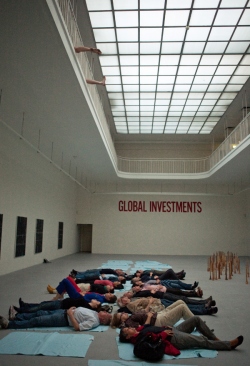
"To me it seems more productive to approach the question of the experienced space as ingenuously as possible and to wait and see what the results are. In this spirit we pose the question of the space's inner structure and how it is presented to the people in their specific experience."
Otto Friedrich Bollnow, Der erlebte Raum, 1956
Information on the basic format
Application of the basic format to new spaces
Inspektion: Kunstverein Freiburg
Inspektion: Winterfoyer
Three dancers and two musicians deal with the inner structure of a room. During that process, the traditional borders between audience and stage are vanquished. The audience follows the performers to different places in the room. The aim is for each recipient to experience a different evening.
The basic format was developed in the premises of the Kunstverein Freiburg, a showroom that has evolved into a nationally and internationally renowned institution. It exclusively deals with current tendencies of contemporary art. Being situated in the former Marienbad it is a place that has already been reinterpreted in its function: from a public swimming pool to a gallery.
This room became an archive for very personal experiences to the artists Verena Hehl, Oleg Kaufmann and Doro Eitel - dance and performance - sowie Jan F. Kurth, Sylvia Oelkrug and Konrad Wiemann - music and composition. They designed a play in which different improvisational models from the area dance and music were applied to other art forms as well as to the room itself.
The performers' actions refer to the topics distance and proximity, intimacy and publicity, compression and perspective. Again and again they measure the room anew, divide it among themselves and let new spaces appear in it and disappear again. At the same time their actions are based on loose sequences of improvisation that they have practiced in this place before. All this always happens under special consideration of a certain permeability and candor for the recipients. The performers can at any time change the course of the evening and adapt their actions to the needs of the audience.

When the spectators enter the chosen room, they are picked up, either one by one or in groups, by performers and are led to different places of the location. Here the artists perform small plays, carefully involve the audience in scenes and situations and thereby equip them with new insights into the room and the performers' personal experience. The spectators repeatedly have the opportunity to follow a certain performer to another room or join a different group.
"The imperative of participation, of an ongoing involvement in the communication networks has to be considered as a context for new forms of theater that deny the accustomed frontal perspective, the role-play and the empathy."
Patrick Primavesi, Zuschauer in Bewegung, 2008
When applying the format to new premises, there's a special focus on what different perspectives there are to offer to the spectators. They are put into different positions as well: they can be lying down, watching the scene through bars or from outside the room; they can be in the middle of things, watching top down or bottom up, upside down or while sitting or standing. Another aspect is the experience of sonority: here, too, there are certain possibilities: the audience can be surrounded by sound, they can be outside the range, directly and closely affected by sound or perceiving it from far. There can be moving sound sources; sound in small and large rooms, from above, from below or right from the center of action.
The reinterpretation, or association and unexpected use of the rooms play another important role. The inventory that a room has to offer is also taken into account.
Every now and again single spectators can enjoy a private performance of an artist or they have the casual opportunity to actively participate in the action. Eventually each spectator will experience the evening a little differently. He or she goes on an individual journey by being able to choose and accept or reject the performers' offer. Plus, there repeatedly are opportunities for the audience to barge in the action.
to Inspektion: Kunstverein Freiburg
Badische Zeitung, July 25, 2011:
Einsichten und Aussichten